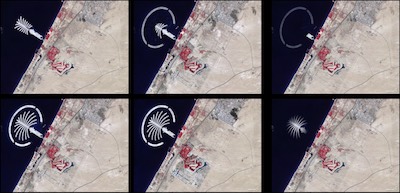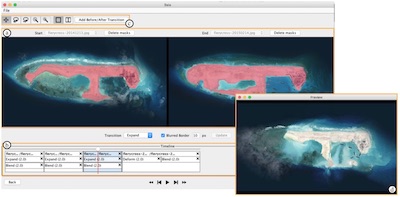
Baia is a framework to create advanced animated transitions, called animation plans, between before-and-after satellite images.
Before-and-after image pairs show how entities in a given region have evolved over a specific period of time. Satellite images are a major source of such data, that capture how natural phenomena or human activity impact a geographical area. These images are used both for data analysis and to illustrate the resulting findings to diverse audiences. The simple techniques used to display them, including juxtaposing, swapping and monolithic blending, often fail to convey the underlying phenomenon in a meaningful manner.
Baia relies on a pixel-based transition model that gives authors much expressive power. The animation editor enables authors to easily represent common types of changes thanks to predefined animation primitives and to sequence different changes across time.
M.-J. Lobo, E. Pietriga, C. Appert, Animation Plans for Before-and-After Satellite Images, IEEE Transactions on Visualization and Computer Graphics (TVCG), Volume 25, Number 2, pages 1347-1360, 2019.

See the project's GitLab page.
As Baia relies on OpenCV and FFmpeg, those libraries must be installed before.
Warning: the latest version of OpenCV+java available through a Maven repository is 3.4.2. Make sure you install this version of OpenCV.
On Mac OS X, using MacPorts:
On Mac OS X, using Homebrew:
Instructions also available for Linux and Windows.
Then, install Baia:
Verify that the path in run.sh matches the location of your OpenCV library.
If standard screen: ./run.sh -folder <path_to_folder>
If HiDPI screen: ./run.sh -retina -folder <path_to_folder>
A tutorial for using Baia is available here.
Several examples of before-and-after images are available: